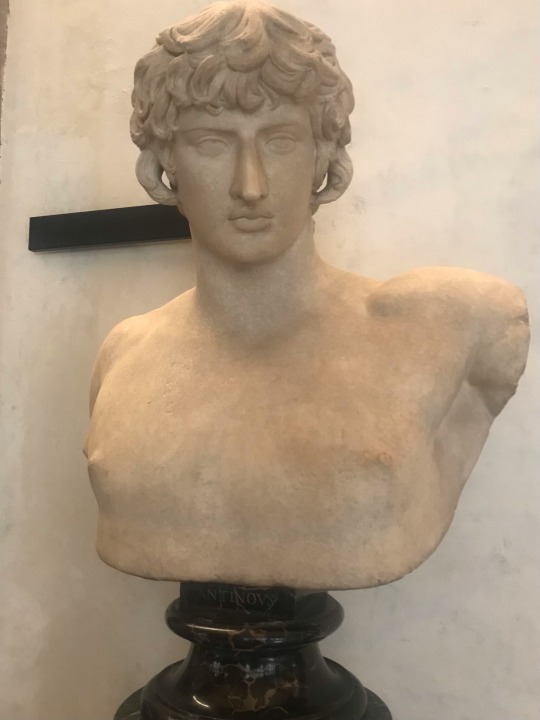Text
Absolutely CRYING that the Aztec God of homosexuality—Xochipilli—has a compound name meaning “Flower Child” or “Flower Boy”.
I AM DONE.
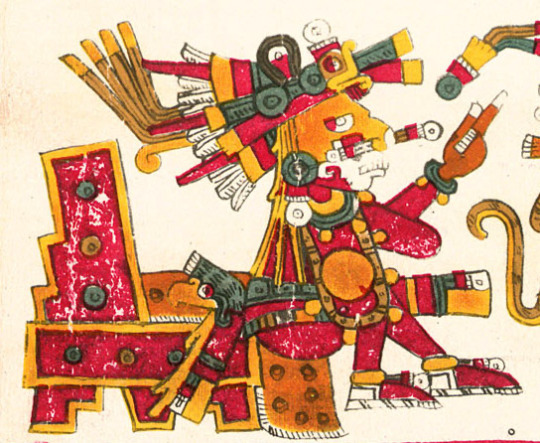
Xochipilli, seated. The Borgia Codex.
26 notes
·
View notes
Text
I remember hearing of an opera about Hadrian in the past. I’m 100% putting this on my watch list.
this website exists??
THE HELLA GAY HADRIAN OPERA :D :D :D
20 notes
·
View notes
Text

This was supposed to be a warm up drawing but I got attached (like always) and I couldn’t make it look the way I wanted😭PLEASE FEEL FREE TO CRITIQUE!! anyway Hadrian x Antinous x douyin yearbook trend☆♪
23 notes
·
View notes
Text
Theseus and the Minotaur
The piece is by Antonio Canova, an Italian sculptor heavily inspired by classical revival. One of his earliest works, it was commissioned by a Venetian ambassador to Rome: Girolamo Zulian. Zulian provided him with the marble and let Canova decide the subject matter. His friend, a Scottish antiquarian and neoclassical painter, suggested Theseus with the dead Minotaur—inspired by Ovid’s Metamorphosis
Antonio Canova. Marble Sculpture. 1781-1782. Victoria and Albert Museum, the Dorothy and Michael Hintze Galleries, Room 22.
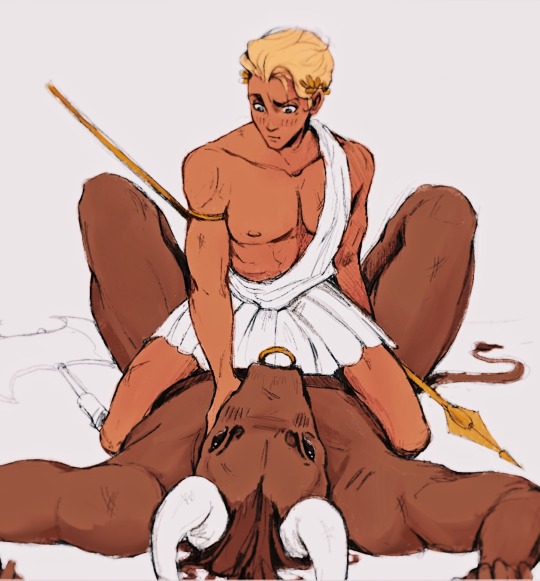
Come on founder/king of Athens, aren’t u gonna slay the Bull of Minos or not?
141K notes
·
View notes
Photo

Masculine Monumental Head, 1st-2nd cetury before J.C.
“This rare bronze head could belong to Apollon’s monumental statue and be a Roman interpretation of a Hellenistic sculpture.”
352 notes
·
View notes
Photo
Did the maenads and Bromius finally make peace with the local wildlife?

The Record-Argus, Greenville, Pennsylvania, December 13, 1920
3K notes
·
View notes
Text
Homosexuality and the First Fifteen Roman Emperors
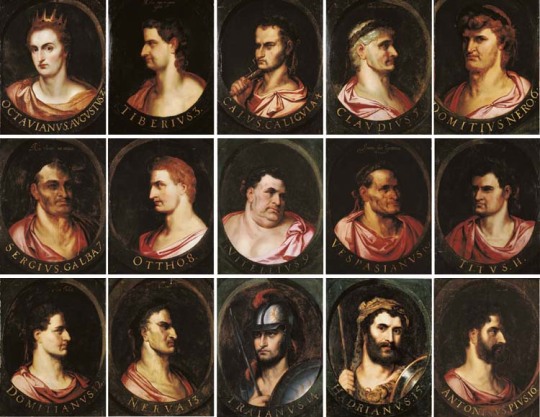
English historian Edward Gibbon (1737–1794) famously declared that "of the first fifteen emperors, Claudius was the only one whose taste in love was entirely correct" [i.e. strictly heterosexual]... but how true is that statement?
I did a little research and, while in no way offering a definitive answer over the matter, found evidence of homosexual activities for thirteen out of fifteen names. Besides the already mentioned Claudius, I didn't find any allegations about Vespasian and Antoninus Pius, who also seemed to be strictly attracted to women.
With the exception of the ones about Nerva and Hadrian, all following quotes were taken from Craig A. Williams' Roman Homosexuality.
(Warning: most quotes include mentions of some kind of non-consensual relationship, including with minors)
AUGUSTUS
Augustus himself acquired the reputation of an avid womanizer, but he also was said to have kept male slaves as his deliciae or “darlings,” one of whom, named Sarmentus, is mentioned in passing by Plutarch.
Augustus, one late source gossips, used to sleep in the midst of twelve catamiti and as many girls.
TIBERIUS
Funerary inscriptions from the imperial household under Augustus and Tiberius reveal that among the different positions filled by slaves in the palace were those of glaber ab cyatho (a smooth boy who served wine), glabrorum ornator (a male slave who served as beautician for the smooth boys), and puerorum ornatrix (a female beautician for boys).
Suetonius’ allusion to Galba’s tastes for mature males is far removed in tone from his explicitly moralizing condemnation of Tiberius’ shocking sexual use of very young boys (what he did “cannot be mentioned or heard, let alone believed”).
CALIGULA
Suetonius uses the coded phrase “pudicitiae neque suae neque alienae pepercit” (“he spared neither his own nor others’ pudicitia,” signifying that he played the receptive and insertive roles in penetrative acts respectively), and then reports some examples in rapid succession: two relationships with men that seem to have involved an exchange of role; an affair with a young nobleman named Valerius Catullus in which Caligula played the receptive role (Valerius claimed to have been worn out by his exertions).
CLAUDIUS
Suetonius has this to say of the emperor Claudius: “He was possessed of an extravagant desire for women, having no experience with males whatsoever."
NERO
Suetonius, Tacitus, Dio Cassius, and Aurelius Victor tell us that the emperor Nero publicly celebrated at least two wedding ceremonies with males, one in which he was the groom and one or perhaps two in which he was the bride, and they provide stunning details: dowry was given, a bridal veil worn.
GALBA
Suetonius records that the emperor Galba was particularly fond of men who were “very hard and grown up,” and it is worth noting that Galba’s fondness for mature men seems to have caused no eyebrows to rise, presumably because he was observing the two basic protocols of masculine sexual comportment: maintaining the appearance of an appropriately dominant stance with his partners and keeping himself to his own slaves and to prostitutes.
OTHO
Dio notes that Galba’s successor Otho alienated many people by having relations with Sporos and generally associating with Nero’s followers.
VITELLIUS
Vitellius began his brief reign as emperor in A.D. 69 by publicly honoring a freedman of his named Asiaticus, with whom he had had a stormy affair when Asiaticus was a young slave of his.
VESPASIAN
[No reports of homosexual activities.]
TITUS
Dio also mentions Domitian’s affair with Earinos, adding that the emperor’s brother and predecessor Titus had shared his tastes for eunuchs.
DOMITIAN
Statius imagines Venus proclaiming that Domitian’s beloved eunuch, Earinos, will surpass in his beauty some legendarily gorgeous young men: Endymion, Attis, Narcissus, and Hylas—the first two of whom were loved by goddesses.
NERVA
It is often insisted that Domitian was sexually abused by his eventual successor, the Emperor Nerva.
TRAJAN
Trajan kept delicati, and this detail is dropped in such a way as to suggest that this was a standard feature of the imperial household.
HADRIAN
Hadrian appears to have preferred the company of men and homosexual relations. The great love of his life, Antinous, was a young man from Bithynia.
ANTONINUS PIUS
[No reports of homosexual activities.]
25 notes
·
View notes
Text

La Fraternité
Jules Dalou was a prolific French sculptor of the 19th century. A great sculptor, he was regularly denied opportunities due to his working class and communist sympathies. Due to his association with the French Commune he fled to England in 1871. He would only return to Paris in 1879 after being granted amnesty.
In the slightly-larger-than-life sculpture a young man holds the hands of an older, seated, and bearded man. Beneath the younger man’s feet are discarded guns, a spear, helmets, and an armor chest plate. Above them three divine women appear ready to crown the bearded man with a laurel, one wearing a Phrygian cap.
The sculpture is in the Salle des Mariages (Wedding Room) of the 10th Arrondissement’s Town Hall.
Aimé-Jules Dalou. 1883. Salle des Mariages, Mairie du 10e Arrondissement.
2 notes
·
View notes
Text

Study of a marriage procession for the Shield of Achilles by John Flaxman, after a description in Homer's Iliad
English, 1818
pen and grey ink with brown wash
British Museum
51 notes
·
View notes
Text
BTW: the history of this specific pair of statues is so needlessly confusing:

Like, if I had a time machine I’d use it to see the originals by Antenor. I’d also give @scribl1ta’s art of them as a little treat :)
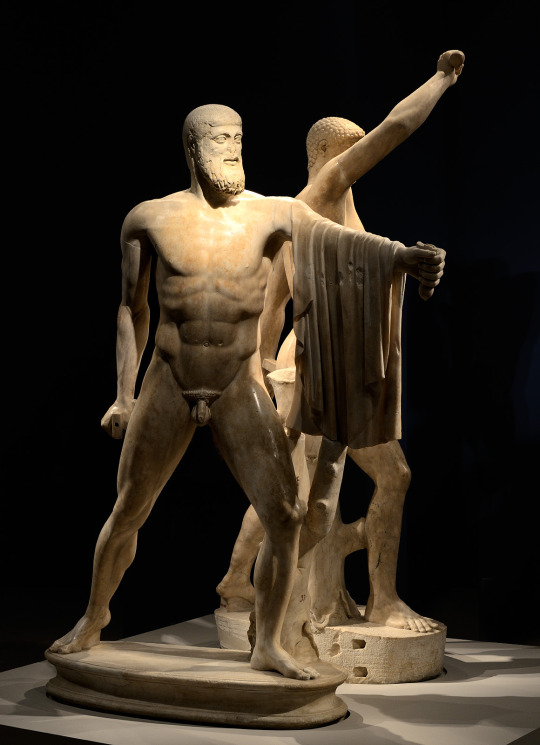
Harmodius and Aristogeiton (Statutory Pair)
Following the death of theAthenian tyrant Pisistratus, his two sons Hippias and Hipparchus came to power in Athens. Herodotus, Thucydides, and Aristotle’s description of the Athenian Constitution all describe how tyrannicides Harmodius and Aristogeiton killed Hipparchus.
Hipparchus attempted to make advances on the young Harmodius. Harmodius was already the lover of Aristogeiton and rejected his advances. Hipparchus, in retaliation, proceeded to invite Harmodius’ sister to participate in the Panathenaic Festival as kanephoros, a sacred and coveted position in which an unmarried virgin lead the procession to the festival’s sacrifice. Hipparchus then publicly disqualified her on the grounds that she was not a virgin, humiliating and insulting her and Harmodius’ entire family.
Aristogeiton and Harmodius organized a revolt to bring down Hipparchus and Hippias in the middle of the upcoming Panathenaic Festival. In a panic they attacked too early, and, although they killed Hipparchus, Harmodius was killed in the following confusion, Hippias managed to flee, and Aristogeiton was caught, tortured, and executed. Although their revolution failed they captured the imagination of Athenian citizens for centuries to come.
Unknown. 2nd Century CE copy of statues by Kritios and Nesiotes from 477/476 BCE. Museo Archeologico Nazionale di Napoli.
12 notes
·
View notes
Text

Harmodius and Aristogeiton (Statutory Pair)
Following the death of the Athenian tyrant Pisistratus, his two sons Hippias and Hipparchus came to power in Athens. Herodotus, Thucydides, and Aristotle’s description of the Athenian Constitution all describe how tyrannicides Harmodius and Aristogeiton killed Hipparchus.
Hipparchus attempted to make advances on the young Harmodius. Harmodius was already the lover of Aristogeiton and rejected his advances. Hipparchus, in retaliation, proceeded to invite Harmodius’ sister to participate in the Panathenaic Festival as kanephoros, a sacred and coveted position in which an unmarried virgin lead the procession to the festival’s sacrifice. Hipparchus then publicly disqualified her on the grounds that she was not a virgin, humiliating and insulting her and Harmodius’ entire family.
Aristogeiton and Harmodius organized a revolt to bring down Hipparchus and Hippias in the middle of the upcoming Panathenaic Festival. In a panic they attacked too early, and, although they killed Hipparchus, Harmodius was killed in the following confusion, Hippias managed to flee, and Aristogeiton was caught, tortured, and executed. Although their revolution failed they captured the imagination of Athenian citizens for centuries to come.
Unknown. 2nd Century CE copy of statues by Kritios and Nesiotes from 477/476 BCE. Museo Archeologico Nazionale di Napoli.
12 notes
·
View notes
Text


A nurse and nature lover in Canada reportedly captured footage of what she said appeared to be “two witches holding a carcass-eating ritual” with a camera she set up near her home.
“I don’t know what the heck was up with that,” Corinea Stanhope, 36, of Powell River, British Columbia, told Kennedy News. “It really freaked us out, it’s not something you see every day.”
Never have I ever read a more "god forbid women do ANYTHING" story in my life. Yeesh. I hope they had fun!
146 notes
·
View notes
Text
YES YES YES YES YES YES YES
On a larger note, did you use their statue pairs as a reference, @scribl1ta?
Harmodius and Aristogeiton @jarl-of-nordland ⚔️ sketch under the cut

*I'm not tagging this because it's heroic nudity (so sfw) but I can if that becomes an issue.

56 notes
·
View notes

